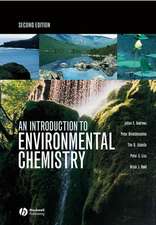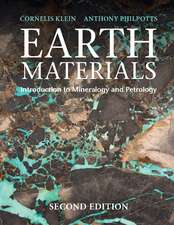Stable Mineral Assemblages of Igneous Rocks: A Method of Calculation: Minerals, Rocks and Mountains, cartea 7
Autor A. Rittmann Contribuţii de V. Gottini, W. Hewers, H. Pichler, R. Stengelinen Limba Engleză Paperback – 15 noi 2011
Din seria Minerals, Rocks and Mountains
-
 Preț: 378.71 lei
Preț: 378.71 lei - 15%
 Preț: 641.38 lei
Preț: 641.38 lei - 15%
 Preț: 692.56 lei
Preț: 692.56 lei - 15%
 Preț: 637.46 lei
Preț: 637.46 lei -
 Preț: 386.00 lei
Preț: 386.00 lei - 15%
 Preț: 639.25 lei
Preț: 639.25 lei - 18%
 Preț: 786.66 lei
Preț: 786.66 lei - 15%
 Preț: 648.42 lei
Preț: 648.42 lei - 15%
 Preț: 645.79 lei
Preț: 645.79 lei - 15%
 Preț: 640.71 lei
Preț: 640.71 lei -
 Preț: 384.70 lei
Preț: 384.70 lei - 15%
 Preț: 635.65 lei
Preț: 635.65 lei - 18%
 Preț: 897.14 lei
Preț: 897.14 lei - 18%
 Preț: 892.74 lei
Preț: 892.74 lei -
 Preț: 379.86 lei
Preț: 379.86 lei - 15%
 Preț: 697.97 lei
Preț: 697.97 lei -
 Preț: 382.75 lei
Preț: 382.75 lei - 15%
 Preț: 637.78 lei
Preț: 637.78 lei -
 Preț: 383.12 lei
Preț: 383.12 lei
Preț: 386.61 lei
Nou
Puncte Express: 580
Preț estimativ în valută:
73.97€ • 77.65$ • 61.40£
73.97€ • 77.65$ • 61.40£
Carte tipărită la comandă
Livrare economică 10-24 aprilie
Preluare comenzi: 021 569.72.76
Specificații
ISBN-13: 9783642654848
ISBN-10: 3642654843
Pagini: 284
Ilustrații: XVI, 264 p.
Dimensiuni: 152 x 229 x 15 mm
Greutate: 0.38 kg
Ediția:Softcover reprint of the original 1st ed. 1973
Editura: Springer Berlin, Heidelberg
Colecția Springer
Seria Minerals, Rocks and Mountains
Locul publicării:Berlin, Heidelberg, Germany
ISBN-10: 3642654843
Pagini: 284
Ilustrații: XVI, 264 p.
Dimensiuni: 152 x 229 x 15 mm
Greutate: 0.38 kg
Ediția:Softcover reprint of the original 1st ed. 1973
Editura: Springer Berlin, Heidelberg
Colecția Springer
Seria Minerals, Rocks and Mountains
Locul publicării:Berlin, Heidelberg, Germany
Public țintă
ResearchCuprins
I. Introduction.- 1. Previous Methods of Calculation.- 2. Nomenclature of Volcanic Rocks.- 3. Systematics of Volcanic Rocks.- 4. Calculation of Stable Mineral Assemblages.- 5. Advantages of Knowing the Stable Mineral Assemblage.- II. Igneous Rock Facies.- 1. Stability of Igneous Minerals.- 2. The Concept of Mineral Facies.- 3. The Volcanic and Subvolcanic Facies.- 4. The Plutonic Facies.- 5. The Carbonatite Facies.- 6. Stable Minerals of the Various Facies.- 7. Mixed Facies.- III. Basic Principles of the Calculation.- 1. Unit of Calculation.- 2. Number of Atoms.- 3. Degree of Oxidation.- 4. Formation of Magnetite.- 5. Saturated Norm.- IV. Igneous Rock Forming Minerals.- 1. Introductory Remarks.- 2. Chemically Simple Minerals and Accessories.- 3. Feldspars.- 4. Nepheline and Kalsilite.- 5. Leucite.- 6. Sodalite Group.- 7. Cancrinite.- 8. Scapolites.- 9. Pyroxenes.- 11. Olivines.- 11. Micas.- 12. Amphiboles.- 13. Melilites.- V. Use of the Key Tables.- 1. Steps Indicating Alternatives.- 2. Steps Indicating the Rules for Calculation.- 3. Graphical Solutions.- 4. Calculation of Complex Minerals.- 5. General Scheme of Calculation.- 6. Determination of the Name of the Rock.- VI. Heteromorphism and Systematics.- 1. Some Heteromorphic Igneous Rocks.- 2. Definition of Plutonic Rocks.- 3. Nomenclature of Magma Types.- VII. Comparison between the Stable Mineral Assemblage and the Mode.- 1. Analytical Errors and Omissions.- 2. Secondary Alteration.- 3. Quantitative Determination of the Mode.- 4. Masking Effect.- 5. Optical Determination of the Average Feldspar.- 6. Presence of Metastable Phases.- VIII. Keys for Calculation.- Key 1: Calculation of the Saturated Norm.- Key 2: Calculation of the Mineral Assemblage of the Volcanic Facies.- Key 3: Calculation of the Mineral Assemblage ofthe “Wet” Subvolcanic-Plutonic Facies.- Key 4: Calculation of the Mineral Assemblage of the “Dry” Subvolcanic-Plutonic Facies.- Key 5: Approximate Calculation of Carbonatites.- Key 6: Determination of Volume Percent and of the Name of the Rock.- IX. Examples.- Example No. 1: “Hawaiian Tholeiitic Basalt”.- Example No. 2: “Alkalic Basalt”.- Example No. 3: “High-alumina Basalt”.- Example No. 4: “Two Pyroxene Andesite”.- Example No. 5: “Cordierite-bearing Rhyolite”.- Example No. 6: “Hyalo-Pantellerite”.- Example No. 7: “Sodalite-nepheline-phonolite”.- Example No. 8: “Leuko-Hornblende-Olivinbasalt”.- Example No. 9: “Leucite-tephrite”.- Example No. 10: “Nephélinite mélilitique à olivine et kalsilite”.- Example No. 11: “Melilitith”.- Example No. 12: “Venanzite”.- X. Appendix.- 1. Key for Calculation of Strongly Altered Rocks (Sil).- 2. Keys for Calculation of the Mineral Assemblages of Ultramafic Rocks.- 3. Tables 21–26 Containing Symbols, Number of Atoms, Abbreviations, Formulae and Molecular Weights, Saturated Norms of Mineral Components, Equations of Field Boundaries.- Comparison of the C.I.P.W. Norm with the Rittmann Norm..- C.I.P.W. Norms of Femic Minerals.- Average Feldspars.- C.I.P.W. Norm and Degree of Oxidation.- Colour Index.- Conclusions.- ALGOL Program for the Computation of the Rittmann Norm..- Purpose of the Programs.- Source Language.- Inclusion of the Nomograms.- Input Data.- The Meaning of the Identification Number.- Output Data.- Application of the Rittmann Norm Method to Petrological Problems..- The Problem of Classification of Volcanic Rocks.- The Problem of Nomenclature of Igneous Rocks.- Comparison of Two Magmatic Regions.- Comparison of Rock Series of Various Ages within a Single MagmaticRegion.- Trends of Magmatic Differentiation Elucitated by the Rittmann Norm System.- Trends of Magma Evolution Displayed with the Aid of the Rittmann Norm System.- Comparison of Volcanic Rocks with Holocrystalline Plutonic Ejecta.- Comparison of Pitchstones and Their Residual Glasses.- References.













